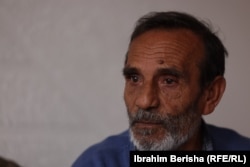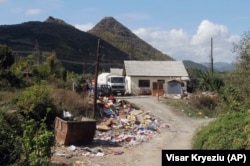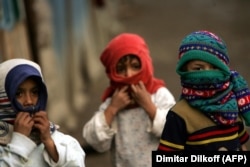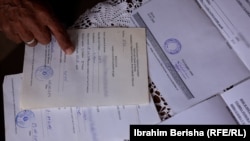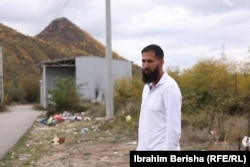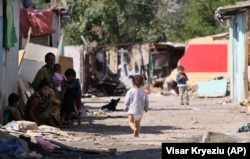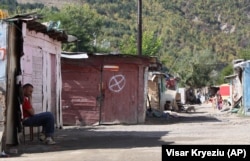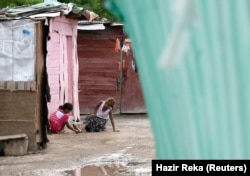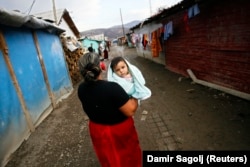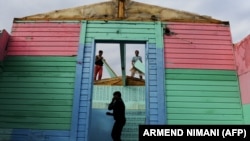Seventy-one-year-old Bajram Babajboksi recalls the bitter hardships of life as a returning refugee in UN-administered Kosovo after the war.
It was initially close on the heels of Serbian-led forces' withdrawal in 1999 from the mostly Albanian breakaway province and very early in the international effort to help Kosovo's 1.7 million people emerge from a decade of chaos and two years of intense conflict.
But for Babajboksi and his family, returning from abroad in Germany was just the beginning. First, their home in a Romany district of southern Mitrovica was burned down alongside about 700 others in an eruption of postwar violence that targeted perceived collaborators with the departed Serbs.
Then they were moved, somewhat reluctantly, into what was supposed to be a short-term UN camp for internally displaced persons (IDPs) near a vast industrial complex known as the Trepca Mines in northeastern Kosovo.
Finally, there were the wretched years in that camp, frequently with no running water, electricity, or heating, as illness proliferated and scarcity forced Babajboksi and his wife to forage in trash bins for food to feed their children and grandchildren.
The nightmare for Babajboksi and other formerly displaced Roma has now extended decades beyond their residency at the notoriously polluted camp at Cesmin Lug, which remained open for years despite testing that showed dangerous levels of lead in the plants and soil.
The United Nations Mission in Kosovo (UNMIK) neared an apology early in 2016 when a rights advisory panel acknowledged a "total failure," including negligence by leaving people in three camps in northern Mitrovica that might have "compromised irreversibly the life, health, and developmental potential" of former residents who had complained of suspected ill-effects.
Seven years later, however, the United Nations still refuses to shoulder the blame for suspected poisonings, provide medical treatment for ailments consistent with lead poisoning among former residents, or compensate the purported victims.
"I don't care about myself," Babajboksi, who along with his wife and 10 other family members spanning three generations spent years at Cesmin Lug, told RFE/RL's Balkan Service recently. "But what I want for my children and theirs is to have long and healthy lives."
Around 600 people -- mostly Roma, Ashkali, and Balkan Egyptians -- were resettled in a handful of camps near the Trepca Mines, northeast of Mitrovica, following burning and looting in the Roma Mahalla neighborhood of southern Mitrovica that left thousands of people homeless in 1999.
They were told that they would be there for 45 to 90 days. The last of the IDP camps was finally closed nearly 14 years later, in 2013.
Beyond the squalor and lack of services at the most notorious camps at Cesmin Lug, Osterode, and Leposavic, there were also high levels of lead in the ground and vegetation.
The Trepca mining and smelting complex, the largest producer of zinc and lead in the former Yugoslavia, also contained three large tailing dams that held mining waste, which has been linked to lead poisoning and environmental damage in the surrounding areas from studies conducted as early as the 1970s.
High concentrations of lead in the bodies of children can lead to brain damage and even death, while pregnant women are at higher risk of miscarriage and can pass lead in their bloodstream on to the fetus.
Other problems associated with lead poisoning include anemia, memory loss and difficulty concentrating, anxiety and insomnia, headaches and stomachaches, fatigue, hearing loss, kidney disease, and high blood pressure.
As early as 2000, UNMIK and NATO's peacekeeping force in Kosovo, KFOR, conducted assessments of the soil toxicity in and around the camps that indicated heavy lead contamination.
KFOR took steps to protect its personnel, including removing at-risk individuals from the area.
A damning report from November 2000 commissioned by the UNMIK and titled First Phase Of Public Health Project On Lead Pollution in Mitrovica Region found that samples from around the camps exceeded acceptable limits by 176 times in vegetation and by 122 times in soil.
The report also recommended relocating the IDPs to a lower-risk area. It was also noted that the costs of implementing the recommendations would exceed UNMIK's financial capabilities.
In 2004, the World Health Organization (WHO) declared the lead toxicity around the camps to be a severe health crisis.
Babajboksi, whose family complained of many of the symptoms indicative of lead poisoning, kept documents that date back to 2002 showing the results of medical tests on his family.
"When I die, my sons and my nephews...will have this documentation that shows what happened," he said.
Irfan Krasniqi, who now lives in the same South Mitrovica neighborhood as Babajboksi, told RFE/RL's Balkan Service on a recent visit to Cesmin Lug that he'll never forget the appalling conditions that he and his family endured in the UN camp.
He says he lives in fear of the symptoms that he saw in a nephew.
Krasniqi says he and other residents couldn't do things that people outside the camps take for granted, such as allowing their children to play freely in the streets or hanging their clothes outside to dry.
"Whenever the wind blew, the clothes were turned completely black," he said.
Sometimes, the children would stop playing with friends and go inside to escape the stench. "We went inside whenever there was a strong smell," Krasniqi said.
He also recalled the aches, exhaustion, and forgetfulness that appeared to affect some of the children.
In 2006, UN and other organizations in Kosovo renewed an emergency call for IDPs to leave the most heavily contaminated camps and "relocate to a safer location immediately."
Stressing that "lead is highly toxic to humans" and the move was particularly important for the health of fetuses and children, the UNMIK, the WHO, and UNICEF warned that lead levels were such that "no amount of remediation on these sites can protect the residents."
The appeal was also directed at local authorities and community leaders.
By September 2006, hundreds of IDPs had moved to the nearby Osterode camp, which had formerly been used by French KFOR troops. But 140 Cesmin Lug residents refused to go, arguing that Osterode, only 150 meters away, was as contaminated as Cesmin Lug.
Rihane Qosa spent more than a decade living among the toxic camps with her four children.
She said her children's suffering made her feel "like doomsday had arrived."
She paid herself for the treatment after medical tests showed lead in the blood of her eldest son.
"A mother can't simply stay quiet when her child is sick," Qosa said.
Former Zitkovac and Osterode camp representative Habib Hajdini says parents are simply trying to get treatment for children who were poisoned and whose welfare has been ignored.
A UN Human Rights Advisory Panel on Kosovo established in 2006 concluded a decade later that camp residents had been subjected to hazardous levels of lead. The researchers suggested that the contamination constituted a violation of the residents' rights to the highest attainable standard of health.
They also recommended that appropriate measures be taken to address the contamination and mitigate its impact on affected individuals. The report identified this failure as discriminatory and recommended that the United Nations "take appropriate steps towards payment of adequate compensation" for moral and physical damages.
The UN, it said, had "failed to follow through on any of the recommendations from HRAP, leaving the victims without redress."
Instead of a public apology, UN Secretary-General Antonio Guterres expressed regret for the camp residents' suffering "but did not acknowledge the UN's responsibility," the report added.
Despite repeated appeals from the families for compensation to help them with medical costs, UNMIK has refused.
"They never gave us a single dinar. No help," said Babajboksi, adding that none of his children or grandchildren had been treated for the poisoning they suffered. "I'm still praying for my children."
Contacted recently by RFE/RL's Balkan Service, UNMIK declined to respond to the question of whether former cam victims of lead poisoning will be compensated except to say that the organization "will continue to make every effort" to build a trust fund and implement projects to benefit the Romany Ashkali, and Balkan Egyptians.
Jasna Causevic from the Germany-based Society for Threatened Peoples (GfbV) has not forgotten about those who were poisoned in the camps in Kosovo. Her group organized a meeting in October to discuss the situation and has asked the German government to take a leadership role in seeking justice for the former Kosovar IDPs affected by lead poisoning.
"We are very disappointed because the UN has violated international standards of human rights," Causevic said. "If the UN violates these standards, what is to be expected from other institutions or the international community?"
Krasniqi says he is not holding out hope that he and his family will ever be compensated, however, believing that the problems stem from racism against minority communities like his.
"If it were any other people, I think [the United Nations] would have acted," he said.
Dianne Post, a U.S. lawyer who represents 198 former IDPs seeking compensation, agrees with the sentiment that the alleged victims' ethnicity might be playing a part in the international response to the claims.
"I have no hope. I don't believe [reparations] will ever happen," she said. "Because the Roma aren't powerful enough, and they don't have a powerful enough country behind them to support them."
She believes the only way forward is a lawsuit on their behalf before the International Court of Justice (ICJ) -- something that only sovereign parties to the ICJ can do.
"And I have tried -- I've tried France and Germany and Serbia and India and the U.S.," Post said. "None of them will do it."
Jonathan Lee, advocacy and communications officer at the European Roma Rights Center (ERRC), says there's another reason why the allegations have yet to yield any positive results. "Anyone who has worked for the UN in any capacity is completely immune from investigation for life," Lee told RFE/RL.
The Convention On Privileges And Immunities adopted in 1946, just months into the United Nations' existence, grants sweeping protection for UN representatives in connection with their actions on its members' territories.
Lee expresses hoped that an UNMIK apology over the apparent camp poisonings might encourage the UN's leadership to withdraw immunity for those responsible for the body's actions in connection with the Kosovar camps.
"Obviously, this did not happen," he said.
In a scathing op-ed from November 2022, a lecturer and students from the International Human Rights Clinic at Harvard Law School who had traveled to Kosovo to research the IDP camp cases alleged that the UN had "maneuvered its own accountability mechanisms to avoid responsibility for lead poisoning in Kosovo."
They said there was "no excuse for UN inaction in this case. The victims' injuries are well documented, and the UN's responsibility is well-established. The only barrier to justice is political will."




